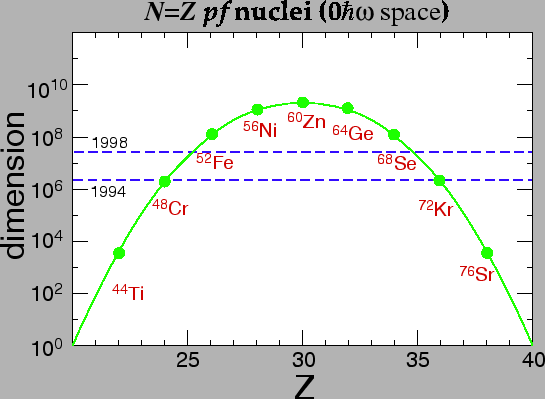To a certain extent, a way out from the explosion of dimensionality,
discussed in Sec. 4.1, may consist in using a better
single-particle space. Instead of parametrizing fields ![]() by
space-spin-isospin points
by
space-spin-isospin points ![]() , one can use a parametrization by the
shell-model orbitals
, one can use a parametrization by the
shell-model orbitals ![]() that are active near the
Fermi surface of a given nucleus, i.e., by fields
that are active near the
Fermi surface of a given nucleus, i.e., by fields
The reduction is now not a mere question of discretizing continuous
fields, but involves a serious limitation of the Hilbert space.
In quantum mechanics one can always split the Hilbert space into
two subspaces,
![]() ,
where
,
where ![]() and
and ![]() are projection operators such that
are projection operators such that ![]() .
Then, the Schrödinger equation
.
Then, the Schrödinger equation ![]() =
=![]() is strictly equivalent to the following 2
is strictly equivalent to the following 2![]() 2 matrix of equations,
2 matrix of equations,
The main questions is, of course, whether the Bloch-Horowitz
effective interaction,
![]() =
=
![]() , can
be replaced by a simple phenomenological interaction, and used to
describe real systems. In particular, when a two-body,
energy-independent interaction is postulated in a very small phase
space, one obtains the shell model, which is successfully
used since many years in nuclear structure physics.
, can
be replaced by a simple phenomenological interaction, and used to
describe real systems. In particular, when a two-body,
energy-independent interaction is postulated in a very small phase
space, one obtains the shell model, which is successfully
used since many years in nuclear structure physics.
 |
In order to illustrate the dimensions of the shell-model Hilbert
space, in Fig. 9 we show the numbers of many-fermion states
that are obtained when states in ![]() =
=![]() medium heavy nuclei are
described within the
medium heavy nuclei are
described within the ![]() space (20 s.p. states for protons and 20
for neutrons). Currently, complete solutions for the
space (20 s.p. states for protons and 20
for neutrons). Currently, complete solutions for the ![]() space
become available, i.e., dimensions of the order of 10
space
become available, i.e., dimensions of the order of 10![]() can
effectively be treated. Progress in this domain closely follows the
progress in size and speed of computers, i.e., one order of magnitude
is gained in about every two-three years. We shell not discuss these
methods in any more detail, because dedicated lectures have been
presented on this subject during the Summer School.
can
effectively be treated. Progress in this domain closely follows the
progress in size and speed of computers, i.e., one order of magnitude
is gained in about every two-three years. We shell not discuss these
methods in any more detail, because dedicated lectures have been
presented on this subject during the Summer School.